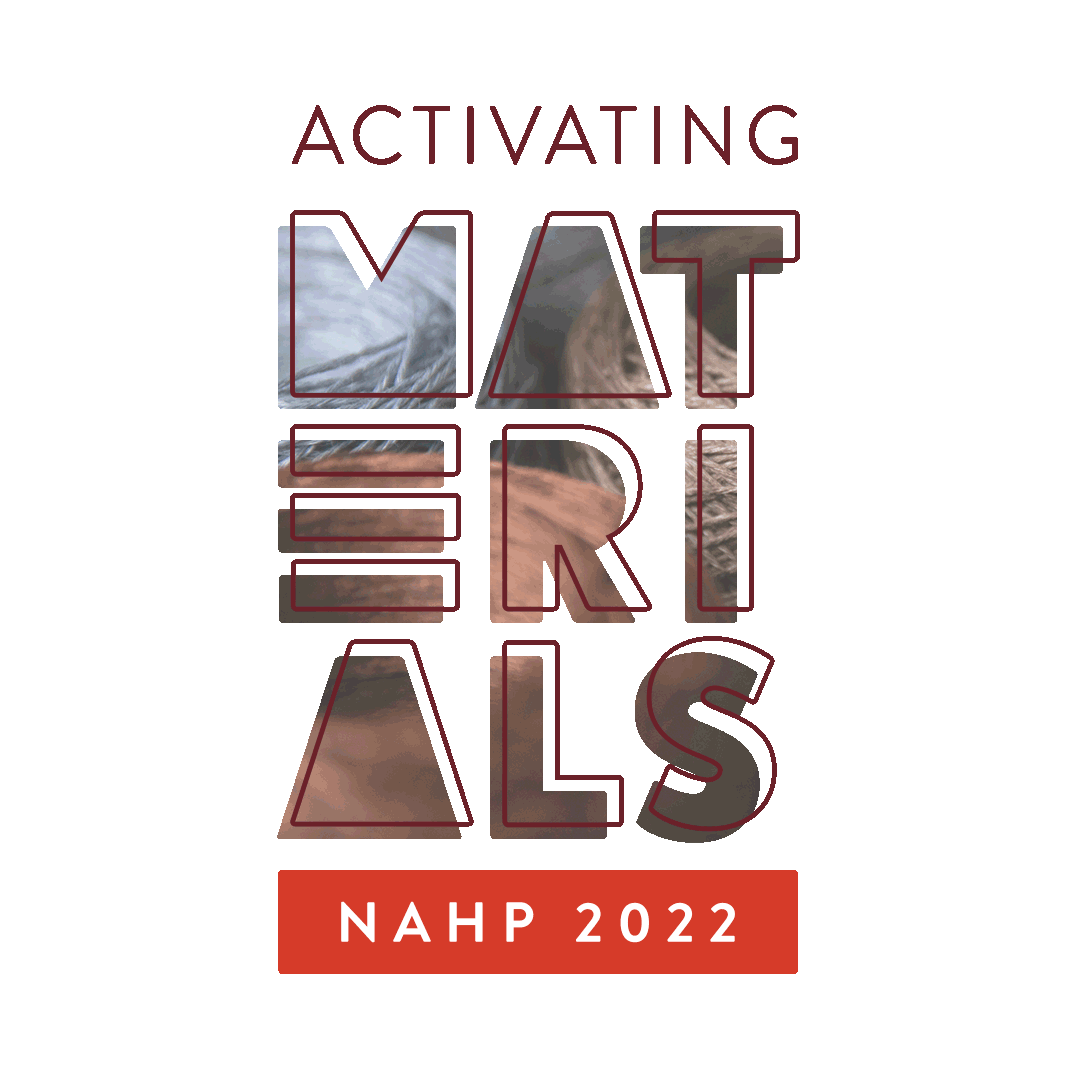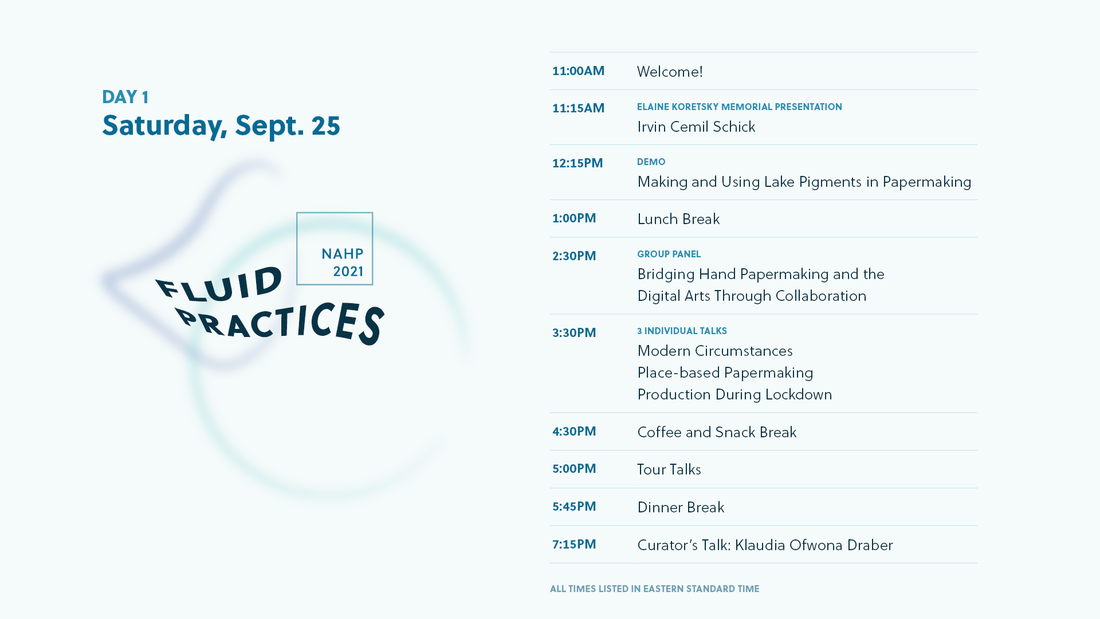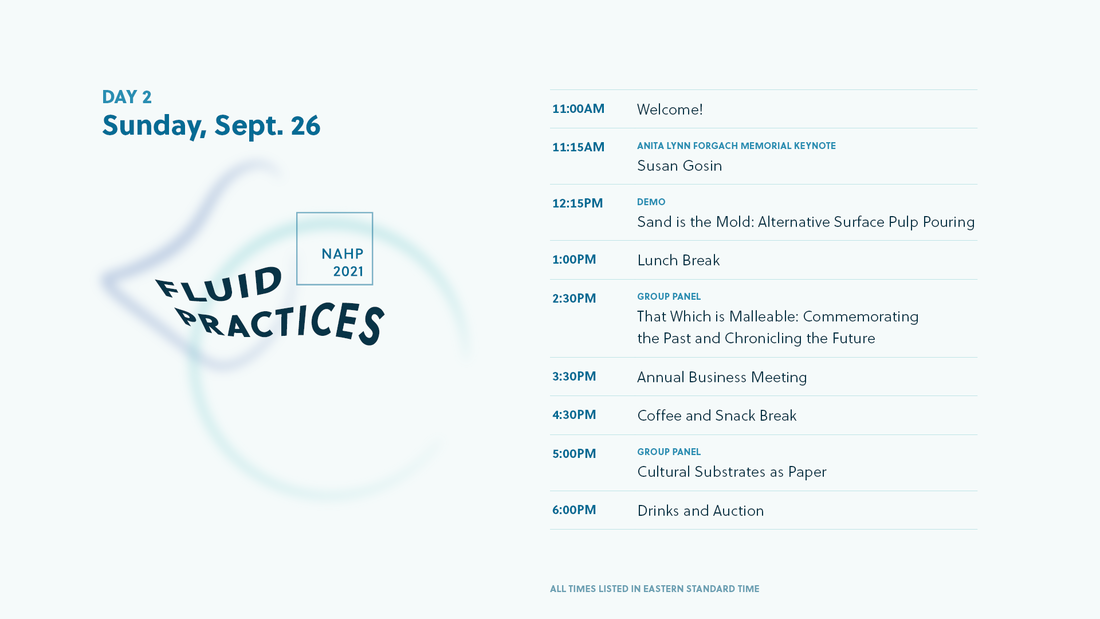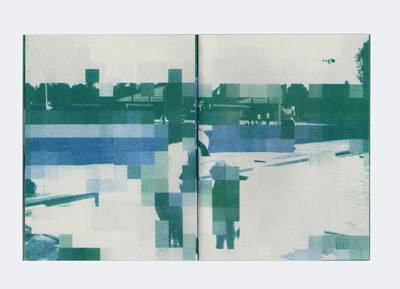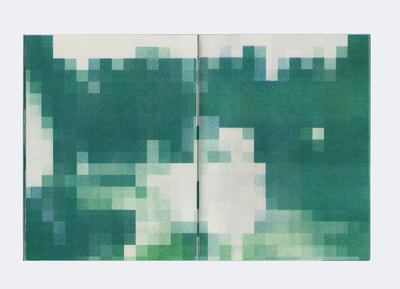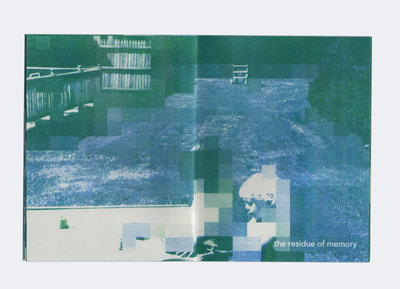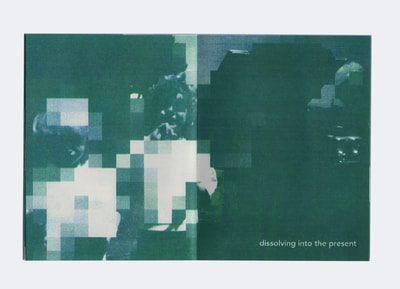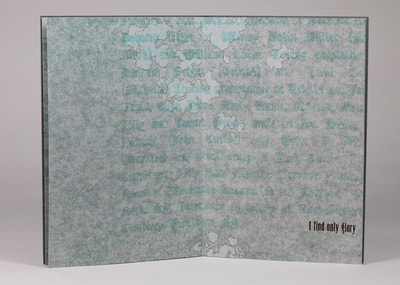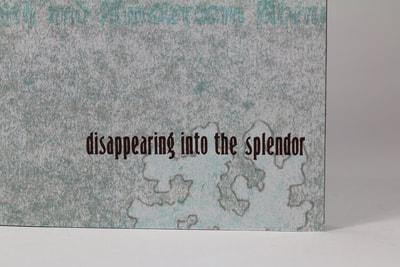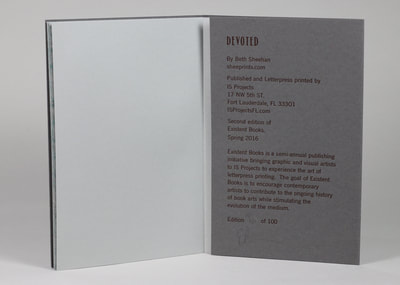Other Projects
Activating Materials: NAHP Virtual Conference, 2022
Kyle Holland and I organized the 2022 North American Hand Papermakers virtual conference.
Activating Materials
The substance of paper alone has the potential to supplement an idea or contribute to the concept or meaning of a work of art rather than abiding as a quiescent substrate for one’s writing or images. Papermaking is an alchemical process through which materials relinquish their original states of being to be transmuted into sheets of handmade paper. It is only when paper exists in this ostensibly fixed state that its maker is presented with a choice to either maintain or neglect that which tethers it—whether physical or figurative—to the past and its intransigent, material integrity.
Papermakers may endow handmade paper with an added layer of value by indicating the raw materials whence the paper was made. Plant fibers sourced from specific locations; machine-made paper; old drawings, prints, book pages, and letters; uniforms; tablecloths; flags; and currency are some examples of materials that have been used to create a physical connection to place or to recycle objects with which memories, stories, and experiences are associated into handmade paper.
Activating Materials
The substance of paper alone has the potential to supplement an idea or contribute to the concept or meaning of a work of art rather than abiding as a quiescent substrate for one’s writing or images. Papermaking is an alchemical process through which materials relinquish their original states of being to be transmuted into sheets of handmade paper. It is only when paper exists in this ostensibly fixed state that its maker is presented with a choice to either maintain or neglect that which tethers it—whether physical or figurative—to the past and its intransigent, material integrity.
Papermakers may endow handmade paper with an added layer of value by indicating the raw materials whence the paper was made. Plant fibers sourced from specific locations; machine-made paper; old drawings, prints, book pages, and letters; uniforms; tablecloths; flags; and currency are some examples of materials that have been used to create a physical connection to place or to recycle objects with which memories, stories, and experiences are associated into handmade paper.
Fluid Practices: NAHP Virtual Conference, 2021
Kyle Holland and I organized the 2021 North American Hand Papermakers virtual conference.
Fluid Practices
Throughout the almost 2,000-year history of hand papermaking, the raw materials, processes, tools, and techniques involved in producing handmade paper have been shaped both by the available resources as well as by limitations of the time. As the world became more interconnected, those resources and ideas began influencing the practice on a larger scale. This adaptability extends to the hands of each maker who imparts their own idiosyncrasies on the objects that they form using the pliant medium of pulp. In the wake of an increasing number of digital technologies and workflows, hand papermaking has continued to prove its fluidity, resulting in a hybridized approach through which traditional processes often interface with software, computer-generated output, and virtual platforms at various stages.
Fluid Practices
Throughout the almost 2,000-year history of hand papermaking, the raw materials, processes, tools, and techniques involved in producing handmade paper have been shaped both by the available resources as well as by limitations of the time. As the world became more interconnected, those resources and ideas began influencing the practice on a larger scale. This adaptability extends to the hands of each maker who imparts their own idiosyncrasies on the objects that they form using the pliant medium of pulp. In the wake of an increasing number of digital technologies and workflows, hand papermaking has continued to prove its fluidity, resulting in a hybridized approach through which traditional processes often interface with software, computer-generated output, and virtual platforms at various stages.
Bookforms, 2019
I wrote a chapter in a how-to book about bookbinding and book arts!
Rockport Publishers teamed up with The Center for Book Arts to compile and publish this book about bookmaking and they asked me to write the chapter on Artist's Books.
The following is excerpted from my section of the book:
Artist books are a unique intersection between the worlds of fine art and bookmaking. They can be almost anything, from altered books to fine bindings, large sculptural objects to miniature books, scrolls to codices, and so much more. To me, every aspect of an artist book should be well considered and the book thought of as an art object. The binding should enhance viewers’ experience as they explore the content and ideas within the book. An artist book should ideally have a reason to be bound in a particular way, either conceptually or formally. For example, if the imagery in an artist book is one long landscape, the artist might choose an accordion structure so that the entire book can be unfolded and seen at once.
Rockport Publishers teamed up with The Center for Book Arts to compile and publish this book about bookmaking and they asked me to write the chapter on Artist's Books.
The following is excerpted from my section of the book:
Artist books are a unique intersection between the worlds of fine art and bookmaking. They can be almost anything, from altered books to fine bindings, large sculptural objects to miniature books, scrolls to codices, and so much more. To me, every aspect of an artist book should be well considered and the book thought of as an art object. The binding should enhance viewers’ experience as they explore the content and ideas within the book. An artist book should ideally have a reason to be bound in a particular way, either conceptually or formally. For example, if the imagery in an artist book is one long landscape, the artist might choose an accordion structure so that the entire book can be unfolded and seen at once.
Between Tenses, 2017
I made a riso book with Waterhouse Ltd., an independent publisher of artist books and multiples!
Between Tenses was printed by Waterhouse Ltd in Philadelphia, USA in 2017. The book was designed by Beth Sheehan and the forward is an excerpt from the book How to Live Safely In A Science Fictional Universe by Charles Yu. It is a limited edition of 70 copies.
Excerpt:
"It's not ideal, obviously, but I guess it's what she wants, to live in a kind of imperfect past tense, in a state of recurrence and continuation, an ambiguous, dreamlike state, a good hour..."
Between Tenses is about hovering in between the past and present. Being consumed by attempts to clarify my past inhibits my ability to form a clear memory of the present, and so it goes. The photographs used in the book were taken throughout my childhood and then altered to simulate my present memory of the events, while the white text is the voice of my present self examining the act of recalling those fragmented moments.
Having no episodic memory of my past, I've fixated on the documentation of my life's history, mainly through childhood photographs and my own writings that strive for clear memory. My artistic process attempts to reconcile what's left of my memory and the sense of borrowed nostalgia that comes with something that feels familiar but unreachable.
Between Tenses was printed by Waterhouse Ltd in Philadelphia, USA in 2017. The book was designed by Beth Sheehan and the forward is an excerpt from the book How to Live Safely In A Science Fictional Universe by Charles Yu. It is a limited edition of 70 copies.
Excerpt:
"It's not ideal, obviously, but I guess it's what she wants, to live in a kind of imperfect past tense, in a state of recurrence and continuation, an ambiguous, dreamlike state, a good hour..."
Between Tenses is about hovering in between the past and present. Being consumed by attempts to clarify my past inhibits my ability to form a clear memory of the present, and so it goes. The photographs used in the book were taken throughout my childhood and then altered to simulate my present memory of the events, while the white text is the voice of my present self examining the act of recalling those fragmented moments.
Having no episodic memory of my past, I've fixated on the documentation of my life's history, mainly through childhood photographs and my own writings that strive for clear memory. My artistic process attempts to reconcile what's left of my memory and the sense of borrowed nostalgia that comes with something that feels familiar but unreachable.
Bookbinding Now: Holland/Sheehan, 2016
Bookbinding Now is a NYC-based audio podcast series addressing all aspects of the book. It was initiated and is hosted by artist and bookbinder Susan Mills.
Kyle Holland and I were interviewed by Susan Mills about our art practices and bookbinding. The episode was released on November 8, 2016. The episode can be found on the Bookbinding Now website, here or through Apple Podcasts.
Kyle Holland and I were interviewed by Susan Mills about our art practices and bookbinding. The episode was released on November 8, 2016. The episode can be found on the Bookbinding Now website, here or through Apple Podcasts.
Existent Books: Spring 2016
Existent Books is a semi-annual publishing initiative which brings artists to IS Projects to experience fine art printmaking and letterpress printing. These artists then design an artist-book that is inspired by our collection of historical letterpress type and image cuts or new printmaking techniques learned at IS Projects. The goal of Existent Books is to encourage contemporary artists to contribute to the ongoing history of book arts while stimulating the evolution of the medium.
With so much of my past missing from my memory, I've become obsessed with the importance of remembrance and mementos. Being in Florida at IS Projects, I was constantly reminded of how much we rely on objects to hold our best memories. It is evident in the eclectic souvenir shops and fun tourist traps that are based on this idea, but it is also evident in so many other moments—the photo booth at FATVillage Art Walk, collecting seashells on the beach, and even being given a marble and learning of the memory the giver attributed to it. We are constantly collecting mementos that capture the beauty of a moment in time. These mementos become our monuments to the best parts of the past.
For this book, I turned to words as mementos and considered the effect that the passage of time has on our memories. Text taken from obituaries reflects on the greatness of one's life using words that become monoliths: beloved, devoted. This text was pressure printed as the first layer of the book. The lichen printed overtop references the blurring effect that time has on our memories, leaving only certain moments unobscured. Finally, the text letterpress printed as the last layer is my response, allowing myself to succumb to the glorification of the past and accepting the flaws of recollection.
Devoted was letterpress printed on our Vandercook SP15 from hand burned pressure plates, prepared by Beth, and handset 24 point Spire lead type. The book is printed on Colorplan 70# grey paper and a 130# Colorplan grey cover. We used the drum leaf binding technique so the book opens completely flat with no disruption of the image. It is a limited edition of 100 copies all hand signed and numbered by the artist.
Text courtesy of artist and IS Projects.
With so much of my past missing from my memory, I've become obsessed with the importance of remembrance and mementos. Being in Florida at IS Projects, I was constantly reminded of how much we rely on objects to hold our best memories. It is evident in the eclectic souvenir shops and fun tourist traps that are based on this idea, but it is also evident in so many other moments—the photo booth at FATVillage Art Walk, collecting seashells on the beach, and even being given a marble and learning of the memory the giver attributed to it. We are constantly collecting mementos that capture the beauty of a moment in time. These mementos become our monuments to the best parts of the past.
For this book, I turned to words as mementos and considered the effect that the passage of time has on our memories. Text taken from obituaries reflects on the greatness of one's life using words that become monoliths: beloved, devoted. This text was pressure printed as the first layer of the book. The lichen printed overtop references the blurring effect that time has on our memories, leaving only certain moments unobscured. Finally, the text letterpress printed as the last layer is my response, allowing myself to succumb to the glorification of the past and accepting the flaws of recollection.
Devoted was letterpress printed on our Vandercook SP15 from hand burned pressure plates, prepared by Beth, and handset 24 point Spire lead type. The book is printed on Colorplan 70# grey paper and a 130# Colorplan grey cover. We used the drum leaf binding technique so the book opens completely flat with no disruption of the image. It is a limited edition of 100 copies all hand signed and numbered by the artist.
Text courtesy of artist and IS Projects.
Benefit Print for the Morgan Conservatory: 2016
I produced this print for the Morgan Conservatory's Annual Benefit for 2016. The print is a two-layer screen print on a variety of papers handmade at the Morgan Conservatory.
Pantone Postcard Project
This was my piece for the Pantone Postcard Project, organized by Emily Martin. Each participating artist received a postcard at random from the Pantone postcard box set of 100. Upon receiving the postcard, each artist was required to alter the postcard in any way they saw fit, responding to the color they were given. The artists would then mail the post cards back to Emily Martin. Martin has organized several venues at which the postcards will be displayed and exhibited.
I was already working with the idea of visual manipulations within my own work through ornamentation reminiscent of kaleidoscopic imagery, as well as the solar orbs often visible on photographs taken in direct sunlight. When I received the Pantone color 17-1524: Desert Sand, I immediately thought of the visual manipulations that occur in the desert from the reflecting light. The result is a linocut of an ornamental form that references the sun and refracting light.
The collection of postcards has been acquired by the Library of Congress!
I was already working with the idea of visual manipulations within my own work through ornamentation reminiscent of kaleidoscopic imagery, as well as the solar orbs often visible on photographs taken in direct sunlight. When I received the Pantone color 17-1524: Desert Sand, I immediately thought of the visual manipulations that occur in the desert from the reflecting light. The result is a linocut of an ornamental form that references the sun and refracting light.
The collection of postcards has been acquired by the Library of Congress!

